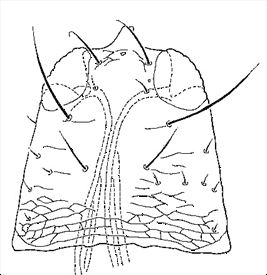Distinguishing features
Female fully winged or apterous. Aptera with body brown; fore tarsi, apices of fore femora, apex of antennal segment II, and base of segment III paler; tube variable from brown to golden brown; major setae brown. Head longer than tube, longer than wide, weakly sculptured near posterior margin; ocelli reduced or almost absent; postocular setae long, fine; 1 pair of long, relatively straight preocellar setae about half as long as postoculars. Antennae 8-segmented; segments III and IV each with 2 sense cones, VII and VIII broadly joined but with a complete suture; IV–VI each with a distinct pedicel. Pronotum with faint lines of sculpture on lateral margins; setae long, finely acute; prosternal basantra absent; mesopresternum almost absent. Mesonotum broadly transverse; metanotum broadly transverse, weakly striate on anterior margin, with 1 pair of long anteroangular setae, 1 pair of small anteromarginals, and 1 pair of long median setae; metathoracic sternopleural sutures broadly expanded. Fore tarsal tooth small. Abdomen: pelta with elongate lateral lobes; tergite II eroded laterally, without posteroangular setae; tergites II–VI with curved wing retaining setae; tergite IX posteromarginal setae stout; tube short, conical, with surface distinctly sculptured, slightly constricted at apex. Macroptera similar to aptera, but wings pale in basal third, slightly shaded distally, and with a brown area around sub-basal setae; legs uniformly brown; head with ocelli; mesonotum broad, with a pair of long midlateral setae; metanotum with 3 or 4 pairs of anteroangular setae; metathoracic sternopleural sutures not heavily eroded; fore wings with 2 major sub-basal setae, subequal in length but arising one behind the other, and 18–20 duplicated cilia.
Male similar in colour and structure to female aptera, fore tarsal tooth large; sternites V and VI with sculptured areas laterally.
Related species
Eight species are listed in this genus, of which five are from New Zealand, two from South Africa and one from Saudi Arabia. H. cumberi and H. cottieri differ from the other New Zealand Heptathrips species in having antennal segment VIII separated from VII by a distinct suture. The South African species H. africanus (Moulton) is similar to H. cumberi in having long postocular setae, but the tube is clear yellow with a dark brown apex and the setae on tergite IX are almost as long as the tube.
Biological data
Feeding on fungal spores on dead branches, under bark, in hollow twigs, and in leaf litter, this species has not been taken in closed-canopy forest. It appears to be associated with the open canopy of manuka scrubland, having been collected several times from Leptospermum.
Distribution data
Widespread in New Zealand (ND, AK, CL, TO / SD, NN, MK, CO), but also known from southeastern Australia and Tasmania.
Family name
PHLAEOTHRIPIDAE, IDOLOTHRIPINAE
Species name
Heptathrips cumberi Mound & Walker
Original name and synonyms
Heptathrips cumberi Mound & Walker, 1986: 25
References
Mound LA & Palmer JM (1983) The generic and tribal classification of spore-feeding Thysanoptera (Phlaeothripidae: Idolothripinae). Bulletin of the British Museum (Natural History). Entomology 46: 1–174.
Mound LA & Walker AK (1986) Tubulifera (Insecta: Thysanoptera). Fauna of New Zealand 10: 1–140.

